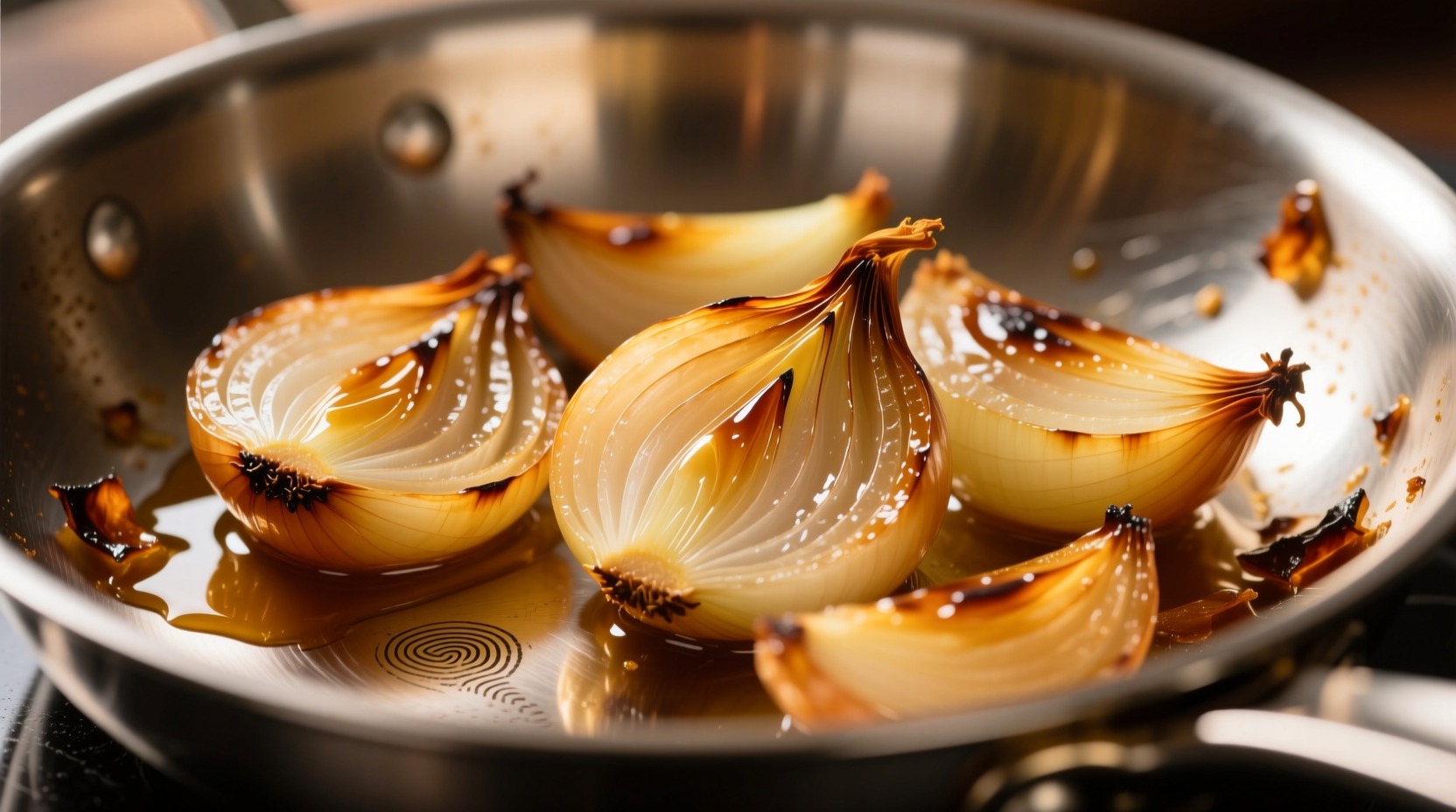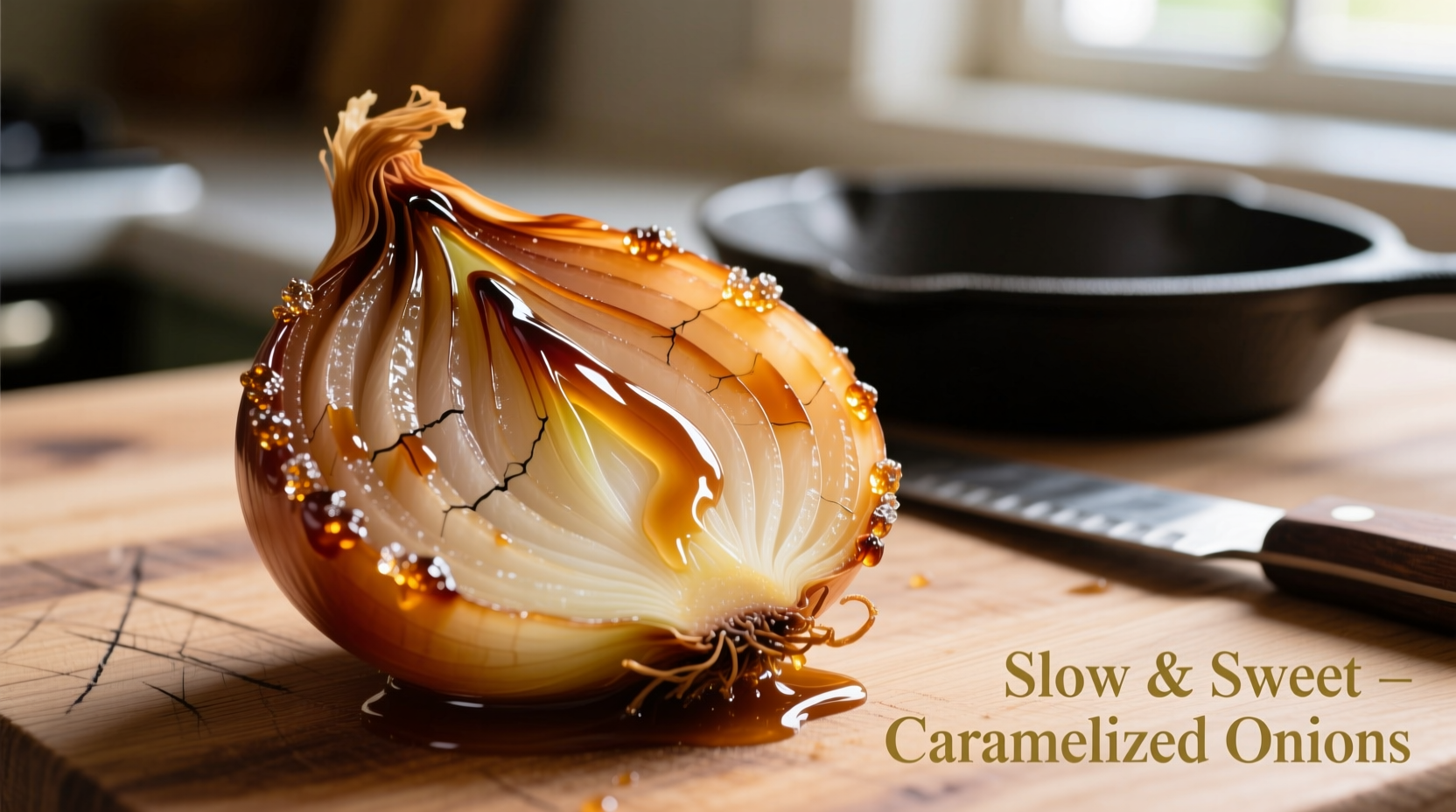Caramelizing onions takes 30-45 minutes of patient cooking over medium-low heat with butter or oil, constant stirring, and proper salt timing to transform raw onions into sweet, golden-brown morsels through the Maillard reaction and sugar caramelization.
Have you ever wondered why restaurant-quality caramelized onions taste so deeply flavorful while your homemade attempts often end up burnt or watery? The secret isn't complicated equipment or rare ingredients—it's understanding the precise timing, temperature control, and chemical processes that transform ordinary onions into culinary gold. Whether you're preparing French onion soup, topping a burger, or enhancing a savory tart, perfectly caramelized onions add a complex sweetness that elevates any dish.
The Science Behind Perfect Caramelized Onions
True caramelization involves two simultaneous chemical reactions: the Maillard reaction (between amino acids and reducing sugars) and actual sugar caramelization. Onions contain approximately 4-5% natural sugars, primarily fructose, which begin breaking down at 230°F (110°C). When cooked slowly, these sugars transform into hundreds of new flavor compounds that create that signature rich, sweet complexity.
| Stage | Time | Visual Cue | Temperature | Chemical Process |
|---|---|---|---|---|
| Raw | 0 min | White/translucent | Room temp | Intact cell structure |
| Sweating | 5-10 min | Translucent | 180-200°F | Moisture release |
| Browning | 15-25 min | Light golden | 210-230°F | Maillard reaction begins |
| Full Caramelization | 30-45 min | Deep amber | 230-250°F | Sugar caramelization complete |
Step-by-Step Caramelization Process
Professional chefs follow this precise method for consistently perfect results. Start with 2-3 pounds of yellow onions (the ideal variety for caramelization due to their sugar content), thinly sliced to 1/8-inch thickness using a mandoline for uniformity.
- Prep your onions: Slice vertically through the root end to maintain structure during cooking
- Heat your pan: Use a heavy-bottomed skillet over medium-low heat with 2 tablespoons of butter or neutral oil
- Add onions: Spread in an even layer without overcrowding
- Initial cooking: Cook 10 minutes without stirring to allow initial moisture release
- Salt timing: Add ½ teaspoon salt after 10 minutes to draw out moisture without accelerating browning
- Stirring pattern: Stir every 5-7 minutes as onions begin to brown
- Liquid additions: Deglaze with 2 tablespoons water, broth, or wine when brown bits form on pan bottom
- Final stage: Cook until deep golden brown, about 30-45 minutes total

Common Mistakes That Ruin Caramelized Onions
Even experienced home cooks make these critical errors that prevent proper caramelization:
- High heat cooking: Temperatures above 250°F cause burning before proper caramelization occurs. The American Chemical Society confirms that optimal Maillard reaction for onions happens between 230-250°F.
- Overcrowded pan: Too many onions create steam instead of browning. Use a wide skillet to ensure proper evaporation.
- Early salt addition: Adding salt in the first 5 minutes draws out too much moisture, preventing browning. Wait until onions begin to soften.
- Excessive stirring: Constant stirring prevents the necessary contact with the hot pan surface. Allow 5-7 minute intervals between stirrings.
Time-Saving Techniques Without Sacrificing Quality
While traditional stovetop method yields best results, these alternative approaches maintain quality while reducing active cooking time:
- Oven method: Spread onions on parchment-lined baking sheet, drizzle with oil, and roast at 375°F for 45-60 minutes, stirring once halfway through
- Slow cooker technique: Cook onions on low for 8-10 hours with 1 tablespoon oil and ½ teaspoon baking soda (raises pH to accelerate browning)
- Pressure cooker shortcut: Sauté onions first, then pressure cook for 10 minutes with natural release for surprisingly good results
According to USDA food safety guidelines, properly caramelized onions can be stored in airtight containers in the refrigerator for up to 5 days or frozen for 3 months without significant quality loss.
Culinary Applications for Perfect Caramelized Onions
Once you've mastered the technique, incorporate your caramelized onions into these dishes for maximum flavor impact:
- Classic French onion soup (adds depth beyond store-bought broth)
- Savory tarts and quiches (replaces raw onions for concentrated flavor)
- Burger toppings (creates natural sweetness without ketchup)
- Pasta sauces (blends seamlessly into tomato or cream sauces)
- Meatloaf and meatball mixtures (adds moisture and complex flavor)
Professional chefs at the Culinary Institute of America recommend adding caramelized onions during the final stages of cooking delicate dishes to preserve their nuanced flavor profile.
Troubleshooting Your Caramelization Process
Encountering issues? Here's how to fix common problems:
- Burning onions: Reduce heat immediately and transfer to clean pan. Add 1-2 tablespoons water to deglaze and continue cooking at lower temperature.
- Watery onions: Increase heat slightly to evaporate excess moisture, but don't rush the process. Properly caramelized onions should have minimal liquid.
- No browning after 20 minutes: Your heat may be too low. Gradually increase to medium-low while monitoring closely.
- Bitter taste: You've likely burned the sugars. Start over—bitter compounds can't be salvaged.
Onion Variety Comparison for Caramelization
Not all onions caramelize equally. Here's how common varieties perform:
| Onion Type | Sugar Content | Caramelization Time | Flavor Profile | Best For |
|---|---|---|---|---|
| Yellow onions | 4-5% | 30-45 min | Rich, balanced sweet-savory | All-purpose caramelizing |
| Vidalia onions | 5-6% | 25-35 min | Exceptionally sweet | Desserts, mild applications |
| Red onions | 3-4% | 35-50 min | Fruity with slight bitterness | Salsas, salads |
| Shallots | 7-8% | 20-30 min | Delicate, complex | Fine dining applications |
Research from the Journal of Food Science confirms that yellow onions provide the optimal balance of sugar content and sulfur compounds for traditional caramelization, making them the professional chef's preferred choice for most applications.











 浙公网安备
33010002000092号
浙公网安备
33010002000092号 浙B2-20120091-4
浙B2-20120091-4